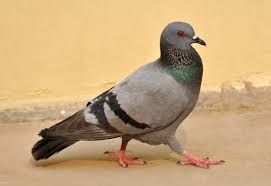
ScientificName:
LifeTime:6 years
Kingdom: Animalia
Phylum: Chordata
Class: Aves
Clade: Columbimorphae
Order: Columbiformes Latham, 1790
The family Columbidae was introduced by the English zoologist William Elford Leach in a guide to the contents of the British Museum published in 1820.[8][9] Columbidae is the only living family in the order Columbiformes. The sandgrouses (Pteroclidae) were formerly placed here, but were moved to a separate order Pterocliformes based on anatomical differences (e.g., they are unable to drink by "sucking" or "pumping");[10] they are now considered to be more closely related to shorebirds.[11] Recent phylogenomic studies support the grouping of pigeons and sandgrouse together, along with mesites, forming the sister taxon to Mirandornithes.[12][13][14][15] The Columbidae are usually divided into five subfamilies, probably inaccurately.[16] For example, the American ground and quail doves (Geotrygon), which are usually placed in the Columbinae, seem to be two distinct subfamilies.[17] The order presented here follows Baptista et al. (1997),[18] with some updates.[19][20][21] The arrangement of genera and naming of subfamilies is in some cases provisional because analyses of different DNA sequences yield results that differ, often radically, in the placement of certain (mainly Indo-Australian) genera.[citation needed] This ambiguity, probably caused by long branch attraction, seems to confirm the first pigeons evolved in the Australasian region, and that the "Treronidae" and allied forms (crowned and pheasant pigeons, for example) represent the earliest radiation of the group.[citation needed] The family Columbidae previously also contained the family Raphidae, consisting of the extinct Rodrigues solitaire and the dodo.[21][22][23] These species are in all likelihood part of the Indo-Australian radiation that produced the three small subfamilies mentioned above,[24] with the fruit doves and pigeons (including the Nicobar pigeon). Therefore, they are here included as a subfamily Raphinae, pending better material evidence of their exact relationships.[25] Exacerbating these issues, columbids are not well represented in the fossil record.[26] No truly primitive forms have been found to date.[citation needed] The genus Gerandia has been described from Early Miocene deposits in France, but while it was long believed to be a pigeon,[27] it is now considered a sandgrouse.[28] Fragmentary remains of a probably "ptilinopine" Early Miocene pigeon were found in the Bannockburn Formation of New Zealand and described as Rupephaps;[28] "Columbina" prattae from roughly contemporary deposits of Florida is nowadays tentatively separated in Arenicolumba, but its distinction from Columbina/Scardafella and related genera needs to be more firmly established (e.g. by cladistic analysis).[29] Apart from that, all other fossils belong to extant genera
The pigeon was sexually dimorphic in size and coloration. The male was 390 to 410 mm (15.4 to 16.1 in) in length, mainly gray on the upperparts, lighter on the underparts, with iridescent bronze feathers on the neck, and black spots on the wings. The female was 380 to 400 mm (15.0 to 15.7 in), and was duller and browner than the male overall. The juvenile was similar to the female, but without iridescence. It mainly inhabited the deciduous forests of eastern North America and was also recorded elsewhere, but bred primarily around the Great Lakes. The pigeon migrated in enormous flocks, constantly searching for food, shelter, and breeding grounds, and was once the most abundant bird in North America, numbering around 3 billion, and possibly up to 5 billion. A very fast flyer, the passenger pigeon could reach a speed of 100 km/h (62 mph). The bird fed mainly on mast, and also fruits and invertebrates. It practiced communal roosting and communal breeding, and its extreme gregariousness may be linked with searching for food and predator satiation.